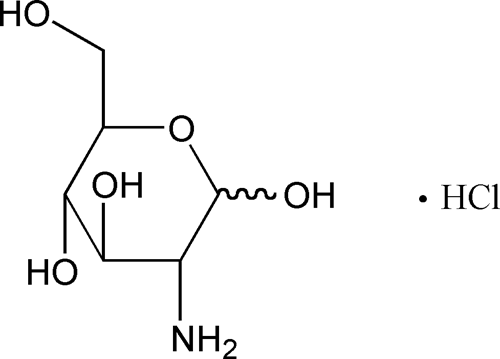Glucosamine Hydrochloride
» Glucosamine Hydrochloride contains not less than 98.0 percent and not more than 102.0 percent of C6H13NO5·HCl, calculated on the dried basis.
Packaging and storage—
Preserve in tight, light-resistant containers.
Identification—
A:
Infrared Absorption  197K
197K .
.
B:
It meets the requirements of the tests for Chloride  191
191 .
.
C:
The retention time of the major peak in the chromatogram of the Assay preparation corresponds to that in the chromatogram of the Standard preparation, as obtained in the Assay.
Specific rotation  781S
781S :
between +70.0
:
between +70.0 and +73.0
and +73.0 .
.
Test solution:
25 mg per mL, in water.
Measure the specific rotation 3 hours after sample preparation.
pH  791
791 :
: between 3.0 and 5.0, in a solution containing 20 mg per mL.
between 3.0 and 5.0, in a solution containing 20 mg per mL.
Loss on drying  731
731 —
Dry it at 105
—
Dry it at 105 for 2 hours: it loses not more than 1.0% of its weight.
for 2 hours: it loses not more than 1.0% of its weight.
Residue on ignition  281
281 :
not more than 0.1%.
:
not more than 0.1%.
Sulfate  221
221 —
A 0.10-g portion shows no more sulfate than corresponds to 0.25 mL of 0.020 N sulfuric acid: not more than 0.24% is found.
—
A 0.10-g portion shows no more sulfate than corresponds to 0.25 mL of 0.020 N sulfuric acid: not more than 0.24% is found.
Arsenic, Method II  211
211 :
3 µg per g.
:
3 µg per g.
Heavy metals, Method II  231
231 :
0.001%.
:
0.001%.
Assay—
Phosphate buffer—
Mix 1.0 mL of phosphoric acid with 2 L of water, and adjust with potassium hydroxide to a pH of 3.0.
Mobile phase—
Prepare a mixture of Phosphate buffer and acetonitrile (3:2). Sonicate for 15 minutes, and pass through a filter having a 0.5-µm or finer porosity. Make adjustments if necessary (see System Suitability under Chromatography  621
621 ).
).
Standard preparation—
Dissolve an accurately weighed quantity of USP Glucosamine Hydrochloride RS in water to obtain a solution having a known concentration of about 1.0 mg per mL.
Assay preparation—
Transfer about 100 mg of Glucosamine Hydrochloride, accurately weighed, to a 100-mL volumetric flask. Dissolve in 30 mL of water, shake by mechanical means, dilute with water to volume, and mix.
Chromatographic system (see Chromatography  621
621 )—
The liquid chromatograph is equipped with a 195-nm detector and a 4.6-mm × 25-cm column that contains packing L7. The flow rate is about 0.6 mL per minute. Chromatograph the Standard preparation, and record the responses as directed for Procedure: the tailing factor for the glucosamine peak is not more than 2.0; and the relative standard deviation for replicate injections is not more than 2.0%.
)—
The liquid chromatograph is equipped with a 195-nm detector and a 4.6-mm × 25-cm column that contains packing L7. The flow rate is about 0.6 mL per minute. Chromatograph the Standard preparation, and record the responses as directed for Procedure: the tailing factor for the glucosamine peak is not more than 2.0; and the relative standard deviation for replicate injections is not more than 2.0%.
Procedure—
Separately inject equal volumes (about 10 µL) of the Standard preparation and the Assay preparation into the chromatograph, record the chromatograms, and measure the areas for the glucosamine peaks. Calculate the percentage of C6H13NO5·HCl in the portion of Glucosamine Hydrochloride taken by the formula:
10,000(C/W)(rU / rS)
in which C is the concentration, in mg per mL, of USP Glucosamine Hydrochloride RS in the Standard preparation; W is the weight, in mg, of Glucosamine Hydrochloride used to prepare the Assay preparation; and rU and rS are the peak responses obtained from the Assay preparation and the Standard preparation, respectively.
Auxiliary Information—
Please check for your question in the FAQs before contacting USP.
Chromatographic Column—
| Topic/Question | Contact | Expert Committee |
| Monograph | Curtis Phinney
1-301-816-8540 |
(DSN05) Dietary Supplements - Non-Botanicals |
| Reference Standards | Lili Wang, Technical Services Scientist 1-301-816-8129 RSTech@usp.org |
USP32–NF27 Page 1029
Pharmacopeial Forum: Volume No. 33(4) Page 691
Chromatographic columns text is not derived from, and not part of, USP 32 or NF 27.

